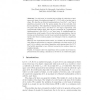Free Online Productivity Tools
i2Speak
i2Symbol
i2OCR
iTex2Img
iWeb2Print
iWeb2Shot
i2Type
iPdf2Split
iPdf2Merge
i2Bopomofo
i2Arabic
i2Style
i2Image
i2PDF
iLatex2Rtf
Sci2ools
WEA
2005
Springer
2005
Springer
Implementing Minimum Cycle Basis Algorithms
Abstract. In this paper we consider the problem of computing a minimum cycle basis of an undirected graph G = (V, E) with n vertices and m edges. We describe an efficient implementation of an O(m3 + mn2 log n) algorithm presented in [1]. For sparse graphs this is the currently best known algorithm. This algorithm’s running time can be partitioned into two parts with time O(m3 ) and O(m2 n + mn2 log n) respectively. Our experimental findings imply that the true bottleneck of a sophisticated implementation is the O(m2 n + mn2 log n) part. A straightforward implementation would require Ω(nm) shortest path computations, thus we develop several heuristics in order to get a practical algorithm. Our experiments show that in random graphs our techniques result in a significant speedup. Based on our experimental observations, we combine the two fundamentally different approaches to compute a minimum cycle basis used in [1, 2] and [3, 4], to obtain a new hybrid algorithm with running time...
Related Content
| Added | 28 Jun 2010 |
| Updated | 28 Jun 2010 |
| Type | Conference |
| Year | 2005 |
| Where | WEA |
| Authors | Kurt Mehlhorn, Dimitrios Michail |
Comments (0)

